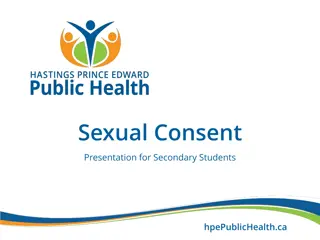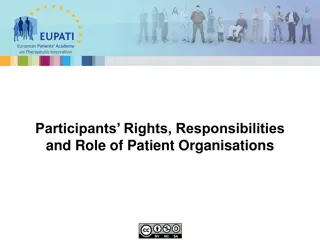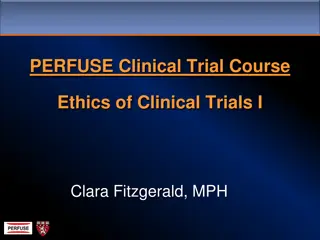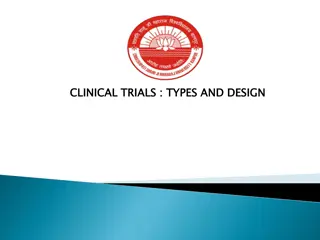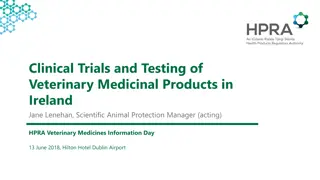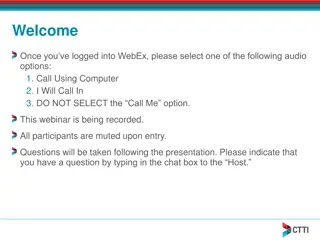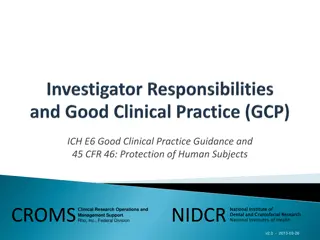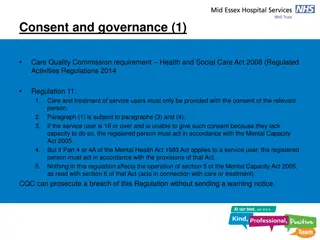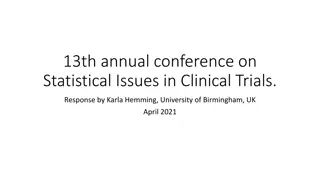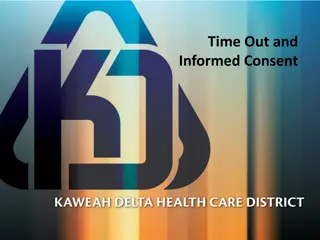Informed Consent Process in Clinical Trials
Millions of volunteers participate in clinical trials each year, necessitating informed consent. Learn about the purpose, history, and elements of informed consent, along with its importance in decision-making. Discover how individuals can protect themselves and make voluntary decisions regarding research participation.
Download Presentation

Please find below an Image/Link to download the presentation.
The content on the website is provided AS IS for your information and personal use only. It may not be sold, licensed, or shared on other websites without obtaining consent from the author.If you encounter any issues during the download, it is possible that the publisher has removed the file from their server.
You are allowed to download the files provided on this website for personal or commercial use, subject to the condition that they are used lawfully. All files are the property of their respective owners.
The content on the website is provided AS IS for your information and personal use only. It may not be sold, licensed, or shared on other websites without obtaining consent from the author.
E N D
Presentation Transcript
TABLE OF CONTENTS 1. INTRODUCTION 2. PURPOSE OF CONSENT 3. WHAT IS INFORMED CONSENT FORM 4. HISTORY 5. BASIC PRINCIPLES 6. ELEMENTS OF INFORMED CONSENT 7. DOCUMENTATION 8. CONSENT AUDIT FINDING
INTRODUCTION Millions of volunteers participate in government and industry sponsored clinical trial each year. Prior to agreeing to participate, every volunteers has right to know and understand what happen during clinical trial . This is called as informed consent and this process that can help to decide whether or not participating in a trial is right for you .
PURPOSE OF CONSENT Prospective Subject Will Understand nature of research Be informed of purpose, risks, and benefits, and alternative therapies Make a Voluntary Decision about Participation.
DEFINING INFORMED CONSENT Informed Consent is defined by the ICH for GCP A process by which a subject voluntarily confirms his or her willingness to participate in a particular trial, after having been informed of all aspects of the trial that are revelent to the subject s decision to participate . Informed consent is documented by means of a written, signed and dated informed consent form
WHAT IS INFORMED CONSENT Informed consent is a communication process :- Between the researcher and the participant. Starts before the research is initiated . Continues throughout the duration of the study . Providing all relevant information to the volunteer/ patient The patient/ volunteer understanding the information provided Voluntarily agreeing to participate A basic right
INFORMED CONSENT ALLOW INDIVIDUALS To determine whether participating in research fits with their values and interests. To decide whether to contribute to this specific research project. To protect themselves from risks. To decide whether they can fulfillthe requirements necessary for the research.
HISTORICAL BACKGROUND OF INFORMED CONSENT 1891- Prussian Minister of Interior , tuberculin for the treatment of tuberculosis must not be used against a person s will. 1898 -Dr. Albert Neisser was fined by the Royal disciplinary court of Prussia for not seeking patient s consent for his experimental studies of vaccination for Syphilis. 1907 -Sir William Osler endorsed the necessity of informed consent in medical research. 1931 -Health Department regulations of German Reich stated that both human experimentation and the use of novel treatment required consent in a clear and unbeatable manner. 1945-1966 NIH funded 2000 research projects, none of them use informed consent Thalidomide-Birth defects is found World war-II and unethical clinical trials done by US Health Services gave birth of Bio-ethics And Creation of IRB and notion of Informed Consent. National Research Act (1960-1970) National Commission for protection of research participants in Biomedical and Behavioral Research.
BELMONT REPORT EXPANDED The definition of Informed consent. Participants-kept informed throughout the experiment, Understand risks and benefits. Protection of vulnerable group.
RULES TO BE FOLLOWED Sponsor Request Institution of Policy(IRB) Federal Regulations -21CFR Part 50 -45CFR Part BASIC PRINCIPLE ICH Good Clinical Practice Guidelines E6 AUTONOMY BENEFICENCE JUSTICE
ELEMENTS IN INFORM CONSENT FORM 1. Protocol number or name of study 2. Purpose of the study. 3. Duration of study and subject involvement 4. A statement that the protocol, and the informed consent were reviewed with the participant, including the risks and benefits of the study. 5. Alternative treatment options discussed. 6. Confidentiality record 7. No. of subjects 8. Compensation for injury
Cont.. 9 - Time for questions to be asked and answered. 10 - Description of the participant s decision 11 - Contact details 12 - Travel reimbursement 13 - Subject responsibilities 14 - Subject satisfaction 15 - Use understandable language 16 - Copy of consent was given to the participant 17 - Sign copy of ICF
INFORMATION THAT SHOULD BE INCLUDED IN I C F 1. Why the research is being done What the researchers hope to accomplish A description of what will be done during the study and how long you are expected to participate The risks to patient from participation in the study The benefits that patient can expect from participation in the study 6. Verification that patient have the right to leave the study at any time, and that standard medical care will be provided without penalty if you choose to withdraw from the study. Although an informed consent document must be signed before enrollment in a study, it is important to remember that informed consent is a process that continues throughout the study. 2. 3. 4. 5. 7.
INFORMED CONSENT FORM READABILITY Language that is easily understood Language must be appropriate to the population being studied Language translators should be qualified and IRB authorized - Consider comprehension as well as readability - Limit medical terminology - Avoid informal speech
COMPLETING THE DOCUMENT All blank spaces completed No additions or deletions Signatures obtained - FDA 21CFR 50 - The patient or authorized representative shall sign and date the informed consent. - 45 CFR 46 - Signed by the patient or legally authorized representative. - ICH GCP E6 4.8 The informed consent should be signed and personally dated by the subject or legally authorized representative. Institutional Policies Document distribution - FDA 21CFR 50 - A copy of Informed Consent shall be given to the patient or representative. - 45 CFR 46 - A copy shall be given to the person signing the form.
WHEN DO WE NEED A WITNESS When presenting the informed consent document orally If required by the IRB Who can be the witness ? Impartial witness a person who is independent of the trial, who cannot be unfairly influenced by people involved in the trial, who attends the informed consent process
REVISION TO INFORMED CONSENT Informed consent documents must be revised every time new safety information becomes available or there is a change in trial procedures, participant compensation or personnel noted on the consent form. Revisions to the informed consent document must be approved by an IRB/IEC prior to its use, and the informed consent process with the new information and documentation needs to be repeated with every clinical trial participant. The participant is then required to sign the revised form.
HOW DOES INFORM CONSENT APPLY TO CHILDREN Children do not have the decision-making capacity to provide informed consent. Therefore, parents or other surrogate decision-makers may give informed permission for diagnosis and treatment of a child, preferably with the assent of the child whenever possible. Other disagreements in care may result in court orders that specify what treatment should occur (for example, blood transfusions), or in the court-ordered appointment of a guardian to make medical decisions for the child. Depending on the type of research, the IRB may make provisions for assent of children Assent A child s affirmative agreement to be a participant in
CONSENTING MINORS AGE >/= 18 Subject or Person obtaining consent sign the ICD Parent/Guardian, witness, and Person obtaining consent sign the ICD *Child Age7-12 Verbal Assent Only *Child Age13-17 Written Assent Required YES NO
INFORMED CONSENT IN PREGNANT WOMEN Researchers should obtain informed consent from both the pregnant woman and the father, Consent of the father is not necessary if The purpose of the study is to meet the health needs of the mother. The identity or where about of the father can not be reasonably as certained. 1. 2.
INFORM CONSENT IN ILLITERATE An investigator may enroll individuals, who can not speak and understand English. The potential subject must be able to place a written mark on the consent form. After that the subject must also be able to: 1. Comprehend the concepts of the study and understand the risks and benefits of the study as it is explained verbally, and 2. Be able to indicate approval or disapproval for study enrollment
INFORM CONSENT FORM IN NON ENGLISH SPEAKING PERSON 1. Ideal is to use consent translated to participant s native language 2. A copy of the consent document must be given to each subject. While a translator may be helpful in facilitating conversation speaking subject, verbal translation of the consent. with a non-English
I C D WHEN PATIENT IS IN INCAPABLE Some factors may make a patient incapable of providing competent consent either temporarily or permanently. Examples include the following: 1. Mental illness or mental retardation 2. Alcohol or drug intoxication 3. Altered mental status 4. Brain injury 5. Being too young to legally make decisions concerning health care
CONSENT AUDIT-FINDINGS Subject signature and person obtaining consent on different dates Subject consented with wrong version of consent/expired consent Subject consented by individual not named on the IRB protocol Check boxes within consent incomplete (future use of samples) Crossed out or white out anywhere on the consent document Subjects not re-consented with revised consent
AUDIO VIDEO VISUALISING High resolutions camera. Audible, clear, no other person involved Order to maintain confidentiality Disturbance free room CD can store at least 5 years after clinical trials Merits Save investigators from future litigation s Increase a transparency rate Demerits : Long term storage On additional step increases 3. Time consuming 1. 2. 1. 2.



